
P.D. GRIFFIN
ENCYCLOPEDIA OF MODERN BRITISH ARMY REGIMENTS
The Queen's Royal Hussars (QRH) were formed in 1993 from two armoured regiments created in 1958 - the Queen's Own Hussars (QOH) and the Queen's Royal Irish Hussars (QRIH) - amalgamations of four hussar regiments which had evolved from dragoons raised in the turbulent days of the seventeenth century: the 3rd (King's Own), 4th (Queen's Own), 7th (Queen's Own) and the 8th (King's Royal Irish). The Queen's title was first conferred on the 7th Dragoons in 1727 with the accession of George II. The Royal title came from the 8th Light Dragoons in 1777. Regimental headquarters are at the Regent's Park Barracks in London.
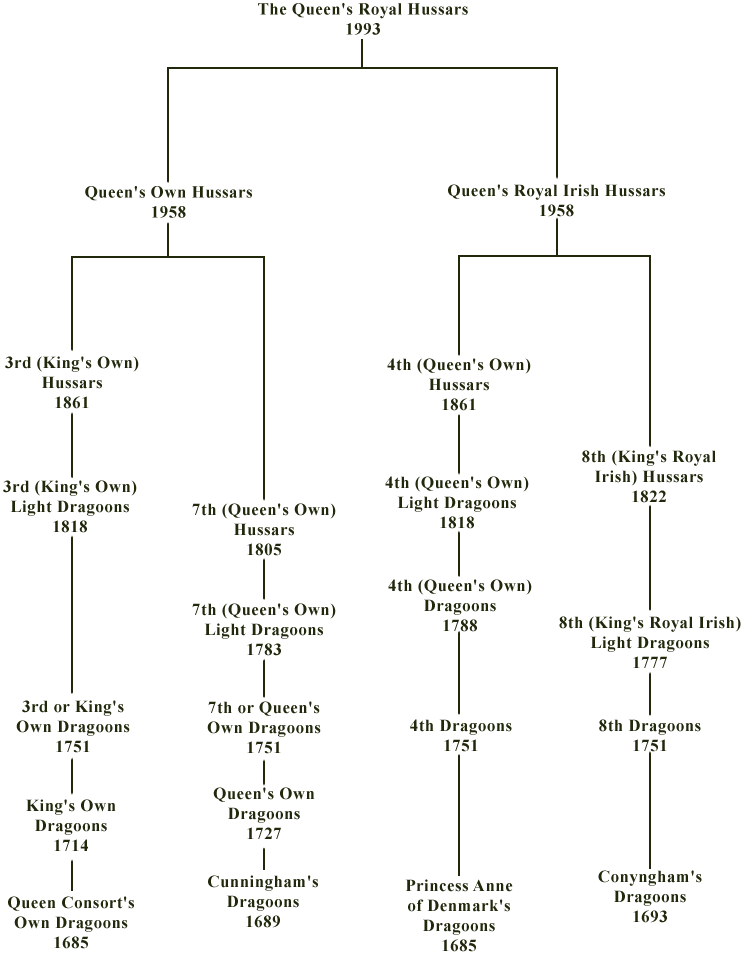
The scarlet peaked cap, a light cavalry custom, was common to both the QOH and the QRIH. The cap badge is made up of the 7th Hussars' Queen's cypher with the royal crest and Irish harp of the 8th superimposed, and a title scroll beneath.

8th Hussars at Bognor, 5 June 1944, prior to leaving for their D-Day dispersal area; some of the officers are wearing the green and gold 'tent hat'. (Bill Bellamy)
The galloping horse collar badge was inherited from the 3rd Hussars by way of the QOH, both of which used it as their cap badge. This Horse of Hanover was authorised to the 3rd Dragoons with their King's title in 1714, when George I of Hanover came to the throne.
The scarlet and silver sleeve badge also came from the QOH. This, the Maid of Warsaw, was awarded to the 7th Hussars by the commander of the 2nd Polish Corps in the Second World War to commemorate the bravery of the regiment when supporting the Poles in the Italian campaign of 1944-5.
Items of QRIH dress perpetuated in the QRH are the green 'tent' hat adopted by the 8th Hussars officers in 1909, green berets and pullovers, and the double chevron worn by lance corporals (8th Hussars).
No. 1 dress 'blues' are light cavalry pattern, regimentally distinguished by the scarlet collar allowed for the 3rd Hussars' uniform in 1861. The Victorian hussar uniform did not have coloured facings, but the 3rd and 13th were permitted to wear collars of their respective facing colours.
Full dress is basic hussar pattern with the distinctions of the senior 3rd Regiment: a Garter blue busby bag and scarlet collar. The busby plume, however, is white and scarlet as worn in the 7th and 8th Hussars.
Irish pipers introduced into the QRIH in 1987 wore a curious green hussar-corded 'doublet' with the traditional Irish saffron kilt and cloak. A plain green doublet replaced the corded type soon after, and pipers and drummers were to be seen in a green caubeen adorned with the regimental white/scarlet hackle.
The regimental quick march combines Von Suppe's Light Cavalry of the QOH with St Patrick 5 Day of the QRIH.
The slow marches of the antecedent regiments together form the regimental slow march: The 3rd Hussars Slow March, which includes General Bland's Inspection March composed in 1745 (probably by his daughter) in honour of the regiment's conduct at Dettingen; Litany of Loretto, based on thirteenth-century Italian plainsong and adopted by the 4th Hussars in 1890; Garb of Old Gaul, marking the Scottish origins of the 7th Hussars; and March of the Scottish Archers from the 8th Hussars.
The regimental trot Encore and the canter gallop Bonnie Dundee are inherited from the QOH.
The regimental motto, Mente et manu (With mind and hand), which comes from QRIH, has graced the badge of the 4th Hussars since 1906. The regimental journal The Crossbelts is named after the journal of the QRIH, inspired by an old nickname of the 8th. At the Battle of Almenara in 1710, Pepper's Dragoons (later the 8th) overthrew a body of Spanish horse and marked the victor)' by wearing the Spaniards' sword belts across their own pouch belts in the manner prescribed only for regiments of horse. The custom was maintained for half a century, so the 8th Dragoons achieved some notoriety in the army as 'The Crossbelt Dragoons'. Battle honour days celebrated in the QRH are Dettingen (27 June), Balaklava (25 October) and Alamein (2 November). Balaklava Day commemorates the 4th and 8th in the Charge of the Light Brigade, and Alamein Day when the 3rd, 4th and 8th Hussars fought in tanks on the Western Desert in 1942. The 3rd Hussars kept 23 October as Alamein Day in memory of their near annihilation when fighting alongside the 2nd New Zealand Division. The fern leaf emblem of the NZ Division was permitted to be carried by the 3rd on their tanks, as the QRH do today.

The QRH pipe major plays in Challenger tanks for arming, Bosnia 1996. (MoD)
At the Battle of Dettingen in 1743, the 3rd Dragoons won great approbation for their repeated charges on the French cavalry, which they penetrated to capture four sets of kettledrums. The King commanded that silver drums taken in the battle were to be paraded on a drum horse with a serjeant drummer and it became a tradition in the regiment for the drummer employed on this duty to wear the silver collar presented by Lady Fitzroy in 1772. The Dettingen drums were destroyed in a fire in 1855 and solid silver replacements procured at the officers' expense were engraved with the battle honours of the regiment and paraded without banners. In the officers' mess of the 3rd Hussars the junior subaltern was expected to wear the drummer's silver collar to dinner. The QRH maintain the drum horse tradition with a mounted drummer in full dress, complete with silver collar.
The Churchill Cup, awarded every year to the best gunnery troop, takes its name from Sir Winston Churchill, who served with the 4th Hussars.
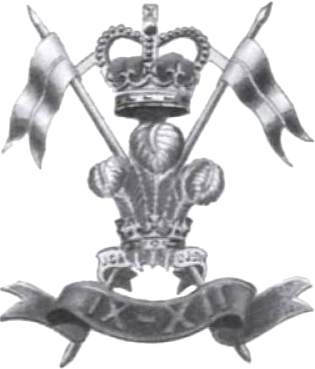

The 12th Light Dragoons re-enactment group in the dress of the 1812-15 period, perfect in every detail except for the horse's undocked tail
The 9th/12th Royal Lancers (9/12RL) were formed in 1960 by the union of two armoured regiments that had survived the cavalry cuts of 1921. Both were raised in the troubled year of 1715 as part of the response to the rebellion in Scotland. In 1816 they were among the first to be equipped as lancers, a class of cavalry modelled on Napoleon's Landers in the recent wars. Regimental headquarters are at Leicester.

Bandsmen of the 9th/12th RL in their new 'Victorian' lancer caps, 1980s
The scarlet peaked cap, with blue piping and quarter welts peculiar to lance regiments, is a legacy of the 12th. Side hats are blue (9th Lancers) for officers and scarlet (12th Lancers) for other ranks. The cap badge combines a crown and the Prince of Wales's crest on crossed lances, with a scroll below marked IX-XII.
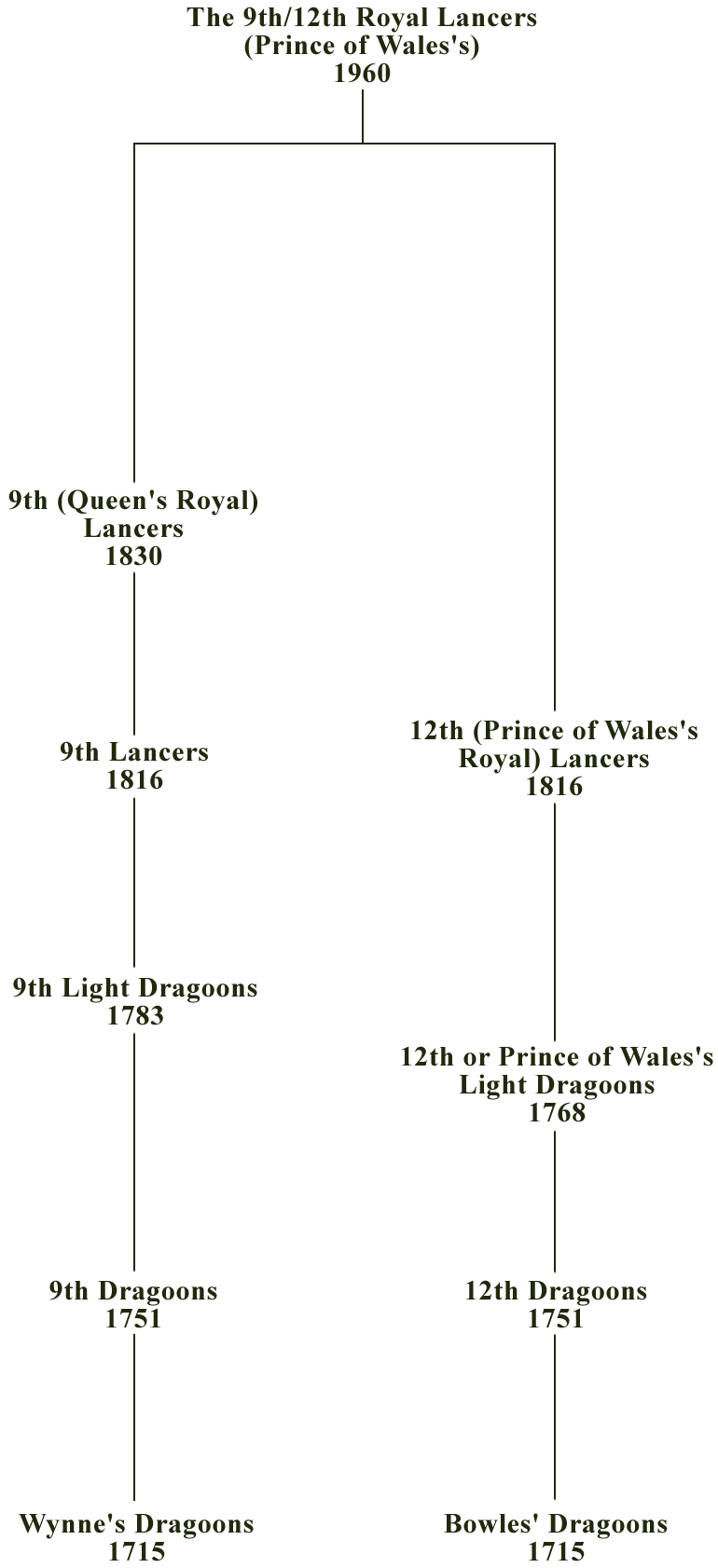
The Prince of Wales's feathers, displayed by the 12th since 1768, are now seen on the NCOs' ranking and on back pouches. Buttons show the AR cypher of Queen Adelaide, reversed and interlaced, on crossed lances with a crown above. The cypher was borne by the 9th from 1830, when William IV inspected the regiment and conferred on it the Queen's title.
Lanyards and stable belts are yellow (facing colour of the 12th Light Dragoons) and scarlet (facing colour of both regiments after their conversion to lancers).
No. 1 dress cavalry pattern has a scarlet collar for officers and a scarlet gorget patch for other ranks. Full dress is lancer pattern with scarlet facings and 9th Lancers' pattern cap (blue top with a black and white plume). Musicians wear the traditional bandsmen's scarlet plume.
The regimental quick march, God Bless the Prince of Wales, is fairly common in regiments with a connection to the title. The slow march is in two parts: Men of Harlech from the 9th and Coburg from the 12th. Other marches in the regiment's repertoire are The Soldiers' Chorus, The Irish Washerwoman, Norma, St Cecilia, Quand Madelon, Pupchen (once played for reveille on May Day) and Low Backed Car.

Caton Woodville's painting of the 9th Lancers at Mons in 1914
The tradition of playing hymns in the evening came from the 12th Lancers, who had three theories for the custom: the wish of the Pope on a visit to Civita Vecchia by officers of the 12th in 1795; an officer's wife who once presented instruments to the regimental band with a request for The Vesper Hymn to be played every night; and - the soldiers' favourite - by order of the Duke of Wellington as a 104-year penance for the 'Supple Twelfth', whose Peninsular War record was reportedly blighted by a raid on a nunnery where 104 bottles of wine had been liberated. In the event, Sicilian Vespers, The Russian Hymn and Spanish Chant were played by the regimental band every evening and on dinner nights in the mess until 1939, and again after the war, but on a less frequent basis.

An enthusiast of the 10th Dragoons (see The Ring's Royal Hussars) in the regiment's attire of the 1750s
Mons/Moy Day marks the last mounted charges with the lance, made by C Squadron, 12th Lancers on 28 August and B Squadron, 9th Lancers on 7 September 1914 against German dragoons.
The regimental journal, The Delhi Spearman, was named after a reputation gained by the 9th Lancers during the Indian Mutiny - 'The Delhi Spearmen'.
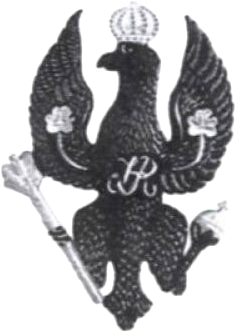
The King's Royal Hussars (KRH) were formed in 1992 from two armoured regiments, the Royal Hussars (a 1969 amalgamation of the 10th and 11th Hussars, which were originally raised for the Jacobite Rebellion of 1715) and the 14th/20th Hussars (a 1922 amalgamation of which the 14th also dated back to 1715).
The King's part of the title dates from 1830, when William IV bestowed his title on the 14th Light Dragoons after inspecting them. The Royal part of the title goes back to 1811, when the Prince Regent honoured the 10th Hussars with it as a public acknowledgement of their valour in the Peninsular War. Of the four antecedents, only the 20th did not boast an extra tide, and were known as 'Nobody's Own'.
KRH headquarters are in Preston (14/20KH) and Winchester (RH).
The regiment's unique crimson peaked cap was inherited from the Royal Hussars, a legacy of the 11th. Its black Prussian eagle ('The Burnt Budgie' in modern army parlance), with its crown, orb, sceptre and FR cypher in gold, was the badge of the 14/20KH. Officers wear the eagle in gilt on a cherry patch for beret and side hat. The emblem was permitted for the 14th Light Dragoons in 1798, after they had provided an escort for Princess Frederika of Prussia en route to her wedding with the Duke of York. The 14th Hussars wore the eagle until 1915, when it was withdrawn because of its Germanic connotations until 1931. The badge was blackened for officers of the 14/20 in the 1950s and for other ranks in 1961.

KRH warrant officer in mess kit, with its crimson lapels and overalls. Note the small Gurkha badge at the top of his sleeve. (Grenadier Publishing)
The Prince of Wales's crest, the badge of the RH and the 10th before them, is now worn on the collars of KRH uniforms. It represents an episode in the history of the 10th Hussars when the Prince Regent favoured them with his patronage. The tradition continued with Prince Edward (Colonel-in-Chief of the 10th in 1863) and his eldest son, the Duke of Clarence, who was gazetted into the regiment and served until his death in 1892. When the Prince Regent became King the most expensive uniforms in the army belonged to the 'Shiny Tenth', whose officers could boast ornamental chains on their pouch belts and cowrie shells on their bridles.
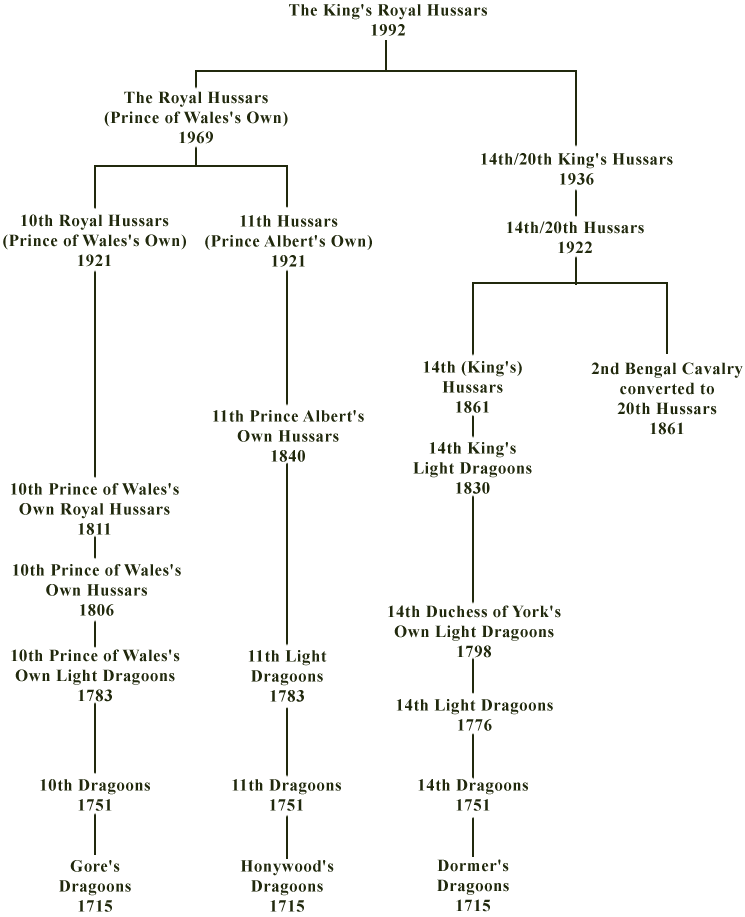
A small silver badge of crossed kukris is worn on the upper sleeve, a custom of the 14/20 which commemorated a Second World War bond with the 6th Gurkha Rifles.
Trousers and overalls worn in No. 1 dress 'blues', No. 2 dress and mess dress are crimson in this regiment, another part of the unique apparel of the RH first worn in the new hussar dress of the 11th designed by Prince Albert in 1840. Lord Cardigan, who had joined the 11th Light Dragoons in 1819, arranged for his regiment to escort Prince Albert on his arrival in England for his marriage to Queen Victoria, and thereby enhanced its status to Prince Albert's Own Regiment of Hussars in the same year. The regiment's famous nickname, 'Cherrypickers', related not to the cherry pantaloons, though, but to an incident in the Peninsular War when a foraging patrol was surprised by enemy dragoons in an orchard.
In working dress the KRH are conspicuous by their cherry/brown berets, another rare distinction of the RH, once the province of the 11th Hussars. When the 11th were mechanised in 1928, berets requested for use in tanks were refused and the quartermaster's wife responded by making a batch out of brown cloth hemmed with a cherry red band.
Full dress is hussar pattern with the distinctive crimson busby bag and overalls worn in the RH and 11th Hussars.
The regimental quick march, The Kings Royal Hussars, heads a list of traditional titles. Coburg, from the 11th Hussars, evokes a family name of Prince Albert and is played in slow time. The Eagle, formerly the slow march of the 14/20, is now used for the general salute.
The 11th Hussars' quick march, Moses in Egypt, celebrated the services of C Squadron in the Egyptian campaign of 1801, which gave the regiment its Sphinx battle honour, a rarity in cavalry circles. For this contribution to regimental honours C Squadron has always enjoyed senior squadron status in the regiment.

King's Royal Hussars corporals in green coveralls and the regimental brown beret, 1995
The march, Royal Sussex, long played unofficially in the 14th, was authorised in 1961 after permission was sought from the colonel of the Royal Sussex Regiment. The march had spread from the one regiment to the other in 1798, when the band of the 35th (Royal Sussex) Regiment stepped in to cover for the band of the 14th Light Dragoons, who were found unfit to play for their regiment after time spent in a Kent tavern.

A corporal of the 14th Hussars in the mounted review order of 1880-1900
Other marches in the regiment's repertoire are Up Light Loo (regimental trot 14/20), Light of Foot (quick march, RH, until 1976), Merry Month of May and God Bless the Prince of Wales.
The band of the Royal Hussars would play the regimental hymns of 'The Don't Dance Tenth' on Tuesdays and Thursdays when in barracks. These were introduced to the 10th by Lt-Col Baker in 1866, to be played between first and last post: Thy Will Be Done, As Pants the Hart and Trent's Chant No. 1.
On guest nights in the officers' mess a toasting cup called 'The Emperor' is used in the tradition of the 14/20, and the 14th Hussars before them. This silver travelling chamber pot was taken by men of the 14th Light Dragoons from the coach of Joseph Bonaparte in the French Army's rout at the Battle of Vittoria in 1813. Subalterns of the 'Emperor's Chambermaids' were not required to drain 'The Emperor' of its liquor after 1929, but officers drank from it for the loyal toast and, after 1969, a special toast to their Colonel-in-Chief, Princess Anne.
The regiment's affiliation with the Royal Gurkha Rifles originated with the 14/20H in 1942. In 1945 they came together with the 6th Gurkha Rifles again for the push through Italy and attacked a German Panzer division at Medicina. The KRH keep 16 April as Medicina Day in the way of the 14/20.
Other important regimental anniversaries are Ramnuggur Day (22 November), commemorating 'The Ramnuggur Boys' of the 14th and their death or glory charge against the Sikh cavalry in 1848; Ramadi Day (28 September), traditionally celebrated in the corporals' mess of the 14th Hussars in honour of their action against the Turks in 1916; El Alamein Day (23 October); and Balaklava Day (25 October), when the 11th Hussars charged with the Light Brigade in 1854.
The custom of sounding the Last Post at 2150 hr, instead of the regulation 2200, began with the 11th Hussars. It was their way of honouring their famous leader, Lord Cardigan, who died at this hour.
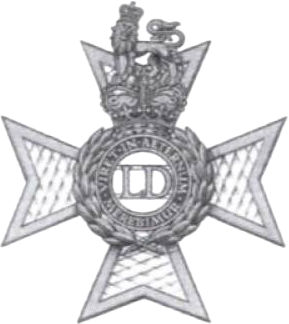
Unlike other armoured reconnaissance regiments created in the 'Options for Change' mergers of 1992, the Light Dragoons (LD) opted to change from the obvious hussar titles of their recent history and reached further back, to a time when their antecedents were light dragoons. The original four were linked tip in 1922 as the 13th/18th Hussars and the 15th/19th Hussars.

In No. 1s for the Guidon Parade, Germany, 1995. (Light Dragoons)
The Light Dragoons' headquarters are at Newcastle upon Tyne, the former home of 15/19H - The Geordie Hussars'. The 13/18H were 'Yorkys' and the LD still recruit in Yorkshire and the north-east. Diana, Princess of Wales, was the first Colonel-in-Chief of the regiment, and in 2003 King Abdullah II of Jordan was appointed to the post.

18th Hussars with a 'captured' French eagle during a Napoleonic encounter, 2004
The scarlet peaked cap (15/19H) is mounted with the Maltese Cross which distinguished shakos of the light dragoon regiments from 1832, a bold departure from normal badging practice. The cross is superimposed with the lion and crown (15H) above a wreathed circle encompassing the monogram LD and inscribed with the mottoes Viret in aeturnum (Forever green - 13H) and Merebimur (Worthy of our deeds - 15H). The badge is mounted on a scarlet backing, a 15/19H custom that is noticeable on the blue beret.
The 13/18H were recognisable by their unique white caps (with blue band), which inspired nicknames like 'The Milkmen' and 'The Sailors'.
Except for a buff white collar (the uniform distinction of the 13th), No. 1 dress blues' are 15/19H pattern: scarlet cap, box chainmail shoulders, the lion and crown NCOs' sleeve badge (15LD by royal permission, 1801) and light cavalry double yellow stripe on trousers/overalls. The white collar is adorned by gold Austrian lace for officers and a badge for other ranks. The Austrian lace commemorates a charge at Villers-en-Cauchies in which the 15th Light Dragoons scattered six French battalions to save the Emperor of Austria from defeat. The collar badge is composed of the lion and crown crest of the 15/19H on the Z-shape scroll that formed the backbone of the badge of the 13/18H.
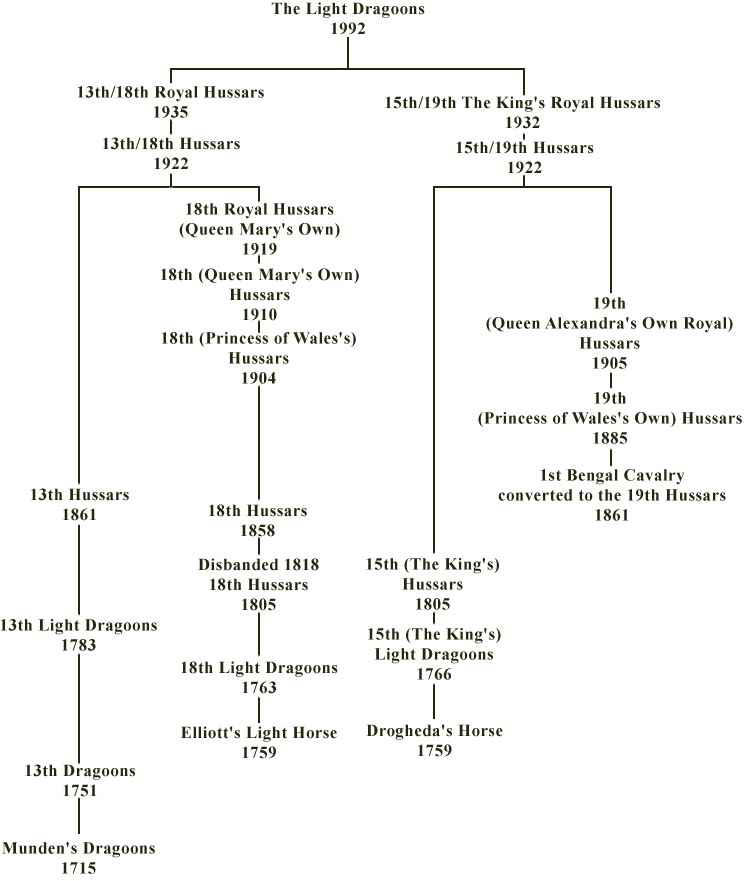
The blue mess dress features a buff white waistcoat in addition to the buff white collar.

Bandsmen of the 13th/18th Royal Hussars in the 1980s. The white facings originated with the 13th Hussars
Cross belt pouches are mounted with a silver elephant and its battle honour 'Assaye'. These honours, given for service in India at the start of the 19th century, were won by the 19th Light Dragoons (1781-1821) and authorised to the 19th Hussars in 1874.
In service and combat dress a large blue/white South Africa flash is worn on the sleeve, a custom of the 13/18H. Its name comes from the helmet patch used to identify the 13th Hussars in the Boer War.
The regimental quick march, Balaklava, originated as a ballad sung after the Crimean War and was adopted by the 13th Hussars to mark their part in the battle. The slow march, Denmark, comes from the 19th Hussars, whose Colonel-in-Chief, Queen Alexandra, was of Danish extraction.
Other marches are Elliott's Light Horse, The Bold Kings Hussar, Sahagun Song and Haste To The Wedding (15/19H). A Life on the Ocean Wave was played by the 13/18H before their quick march to mark the crossing to Normandy in 1944, where they went ashore in amphibious tanks.
Sahagun Day (21 December) marks the 15th Hussars' surprise attack on the snow- covered garrison in Spain in 1808. The story of how Lord Paget led them by the light of the moon used to be retold in a ballad sung by the band on this day.
Balaklava Day (25 October) remembers the exploits of the 13th Light Dragoons on the front rank of the Charge of the Light Brigade in the Crimea in 1854.
Assaye Day (23 September) was celebrated in the 15/19H for the first time in 1924. It remembered the old 19th Light Dragoons at the bloody Battle of Assaye, the culmination of the First Mahratta War in 1803.
Esla Day (31 May) was first observed by the 15/19H in 1928. It involved the King's Own Yorkshire Light Infantry, whose officers were honorary guests of the 15/19H mess. The two regiments would meet to compete in sport on the anniversary of the crossing of the Esla river in the Peninsular War for a painting that depicts men of the 51st Foot braving the current by clutching at the stirrups of the 15th Hussars. The LD maintain the custom whenever possible.

Band of the 16th/5th Queen's Royal Lancers in their scarlet tunics, c. 1989
Normandy Day (6 June) was kept by the 13/18H for their part in the D-Day Landings of 1944. After the breakout from the coast the regiment was instrumental in clearing the Mont Pincon and enabled the pursuit of the Germans back to the Rhine.
Lajj Day (5 March) commemorated the last mounted charge made by the 13th Hussars. Its recipients were a Turkish rearguard in the advance to Baghdad in 1917.
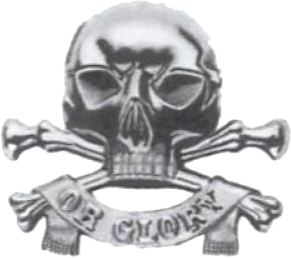
We have much more interesting information on this site.
Click MENU to check it out!
∎ cartalana.com© 2009-2025 ∎ mailto: cartalana@cartalana.com